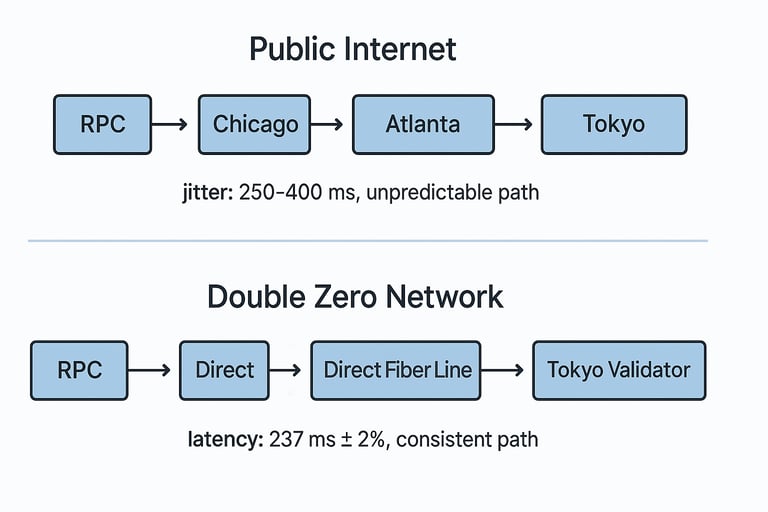Solana Double Zero Project: A New Internet for Blockchain Infrastructure
How the Solana Double Zero project is building a decentralized, high-speed internet layer for blockchains. Discover how it improves validator performance, reduces latency, and scales Solana to 1M+ TPS with fiber routing and edge hardware.
CRYPTO


Solana Double Zero Project: A New Internet for Blockchain Infrastructure
When Austin Federa, former Head of Strategy at the Solana Foundation, announced he was leaving to co-found a new protocol called Double Zero (0x0), it stirred curiosity across the crypto ecosystem. Not just because of his profile, but because of what the project promised: “a new internet for modern distributed systems.”
In this article, we explore what the Double Zero project is, why it’s necessary, how it works at a technical level, and what it means for the future of high-performance blockchains like Solana.
The Ambition: Why Double Zero Exists
Austin puts it plainly: "The ambition of blockchain is still just quite small." Despite all the hype, most blockchain networks still operate far below the performance thresholds of traditional internet infrastructure. Solana, which is pushing toward a million transactions per second, is an outlier. But even Solana is limited not by computing but by the network layer.
"At some point, all sufficiently large software companies have to start looking at hardware, or else they realize their ambitions simply cannot be met." Austin said during his podcast appearance. “We're trying to accelerate that process by a decade for the blockchain industry.”
Blockchains today operate over the public internet, a miraculous system in many ways, but one designed for cost efficiency, not speed. Double Zero sets out to challenge that status quo.
What Exactly Is Double Zero?
At its core, Double Zero is a decentralized, private fiber network designed specifically for blockchain infrastructure. Think of it as an alternative routing layer, a purpose-built backbone for validators, RPCs, indexers, and block engines.
"It builds itself as a new internet for modern distributed systems." Austin explained. "And what we set out to do with Double Zero is to say: this is a solved problem in the corporate world. Private networking has existed for 30 years. What’s new is trying to do this without having one centralized entity run it."
Double Zero is not just a faster pipe. It also provides predictable latency, dedicated bandwidth, and a way to enforce network-level decentralization through crypto-native incentives.
Why the Public Internet Is a Problem for Blockchains
To understand Double Zero’s mission, it helps to understand how packets actually move across the internet today.
"If you ping from New York to Tokyo, your packet's not going straight there. It might go to Philly, then to Chicago, then Atlanta, then Denver, and then back to Boston," Austin said. "It moves all around the world in crazy routes that make no sense unless you look at the cost of the routing path."
This happens because of least-cost routing, a protocol that prioritizes affordability over performance. For most applications—like streaming video or sending a message—this is acceptable. But for blockchain systems where milliseconds can mean missing a block or getting frontrun, this unpredictability is deadly.
And it's not just about latency. There’s jitter, the inconsistency in delivery time between packets and bandwidth congestion, which impacts how much data a validator or RPC can ingest in a given time.


How Double Zero Works: The Technical Details
The Double Zero architecture combines dedicated fiber bandwidth, hardware acceleration, and decentralized governance. Here's how it comes together:
Dedicated Bandwidth & Predictable Latency
“With dedicated bandwidth, you’re not guessing,” Austin explained. “If my RPC is here, and the validator I’m talking to is over there, it’ll always take 237 milliseconds to get there. Within one or two percent variance. Always.”
That consistency is a game changer for services like RPCs and searchers, who rely on predictable performance to land high-value, time-sensitive transactions.
Edge Processing with FPGAs
Another novel aspect of Double Zero is its use of FPGAs (Field Programmable Gate Arrays) embedded in custom switches at the edge.
“A validator spends about 70% of its time just sorting through transactions with invalid signatures or duplicates,” Austin said. “So we said: what if we could do that work in hardware, before it even reaches the validator?”
The result is a system where incoming transactions are filtered, verified, and deduplicated in-flight, dramatically reducing validator load and allowing them to produce better blocks more efficiently.
Multicast State Propagation
Double Zero also enables multicast, sending one packet that the network duplicates to all relevant endpoints rather than individual copies.
“If my validator is building a block and I send out a shred, I only need to send it once. The switch clones it to everyone who needs it” Austin said. “It’s similar in concept to what Turbine does on Solana, but much more efficient.”
This allows for massive bandwidth savings and opens up the door to truly scalable state propagation.
The Token Model and How to Participate
While Double Zero does not yet have a public token, the tokenomics model is designed with decentralization and sustainability in mind.
Validators contribute a fixed percentage of their earnings (e.g., 1%) into a shared pool.
That pool is then auctioned to buyers who pay in Double Zero tokens.
Tokens used in the auction are burned, and bandwidth contributors are rewarded with new token emissions.
“We didn’t want validators to have to worry about topping up a token balance” Austin noted. “That’s a point of failure. So instead, the system auto-converts a portion of their earnings into protocol revenue.”
RPCs, MEV searchers, and indexers will pay directly in Double Zero tokens, especially as more performance-based services come online.
Who Is Behind the Project?
Double Zero is co-founded by:
Austin Federa, former Solana Foundation strategist and host of the Validated podcast.
Mató Ward, with a background in HFT infrastructure and sub-sea fiber.
Andrew McConnell, technical co-lead from Malbec Labs.
As Austin puts it:
"The team isn’t building something that competes with Solana. It’s a base-layer booster for all fast networks. This isn’t a blockchain project, it’s a protocol for connectivity."
The Road Ahead: Testnet, Launch, and Beyond
The Double Zero testnet is already live, connecting 16 cities with four Solana mainnet validators operating over the network. Plans are underway to open onboarding to additional validators, RPC providers, and contributors over the coming months.
“Our goal is that by Breakpoint 2025, we’ve got permissionless validators paying in tokens and running on Double Zero,” Austin said. “That’s the milestone we’re aiming for.”
Future plans include integrating other chains, potentially joining undersea cable consortia, and supporting new use cases like decentralized AI and edge compute.
Why Double Zero Could Reshape the Future of Web3
While many projects aim to optimize on-chain computation, Double Zero tackles the forgotten layer: the network that connects everything.
With its focus on hardware-accelerated performance, deterministic routing, and decentralized incentives, it could become the default connectivity layer for high-speed blockchains.
And as Austin said:
“We all like to talk about pushing toward a million TPS, but the public internet can’t support that. We’re not just raising limits, we’re removing the bottlenecks so protocol engineers can actually use the headroom.”
Final Thoughts
Double Zero is more than a clever optimization, it's a bold rethinking of how blockchain networks communicate. By combining high-performance fiber, open incentives, and decentralized coordination, it offers a credible alternative to centralized ISPs and makes massively scalable, globally distributed consensus a real possibility.
Whether you’re a Solana validator, DePIN builder, or DeFi protocol chasing milliseconds, Double Zero is a project worth watching and eventually, connecting to.
You may also like:
